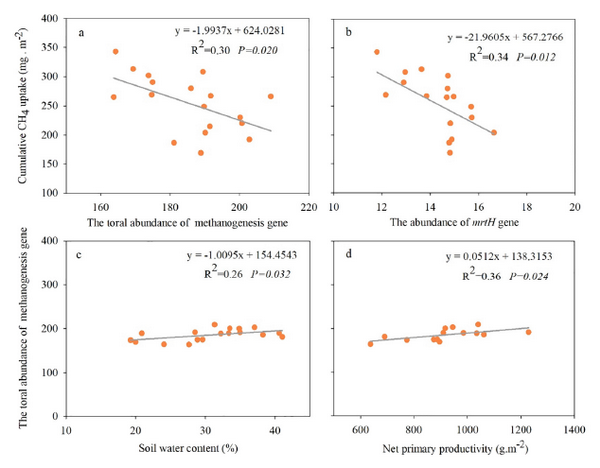Alpine meadows are significant CH4 sink. However, the response of soil CH4 uptake to future climate change in the alpine meadows remains poorly understood. We carried out an alpine meadow field experiments to determine how warming and altered precipitation (drought and wetness) affect CH4 uptake, as well as its underlying mechanisms. Our results showed that this mesic alpine meadow was a CH4 sink under all treatments (ranging from -311.4 to -487.1 mg m-2 CH4). Warming significantly increased CH4 uptake by an average of 18.14% of the annual cumulative CH4 uptake and by 48.68% of the non-growing season cumulative CH4 uptake. Drought enhanced the positive warming effect on CH4 uptake by decreasing soil water content, but wetness weakened this effect. Moreover, using high-throughput sequencing and GeoChip approaches, we found that warming stimulated CH4 uptake not only by increasing CH4 oxidation but also by decreasing CH4 production through changing the methanotroph community compositional structure. Further analysis revealed that the dynamics of daily CH4 uptake were mainly regulated by soil water content during the growing season, whereas daily CH4 uptake was strongly correlated with soil temperature during the non-growing season. Warming and altered precipitation influence soil CH4 uptake in different ways during the growing and non-growing seasons. Based on our results, we predict that Tibetan Plateau mesic alpine meadows will remain a net sink of CH4 under future climate warming and drought scenarios, but soil CH4 uptake will decrease if precipitation increases in future.

Fig. Correlations between the cumulative CH4 fluxes during the growing season and the total abundance of methanogenesis gene (a) and the individual mrtH gene (b) in 2013, and the correlations between total abundance of methanogenic genes and soil water content (c) and net primary productivity (d) in 2013, respectively.
This result was published in Science of The Total Environment with the title of “Atmospheric water vapor and soil moisture jointly determine the spatiotemporal variations of CO2 fluxes and evapotranspiration across the Qinghai-Tibetan Plateau grasslands”.
The link below will guide you to the reading:
https://www.sciencedirect.com/science/article/abs/pii/S0048969721034501
